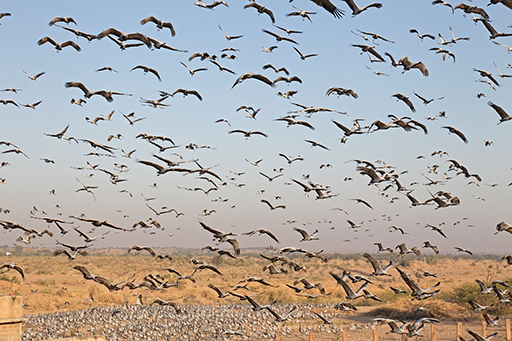4 Homer’s oral art II
Another characteristic feature of Homer’s oral poetry is the simile. In similes, the poet compares one thing to another: so and so is ‘like’ x. For example, at Iliad 21.461–7, Apollo backs out of fighting with his uncle Poseidon, the earth-shaker, ‘for the sake of mortals’ because they are:
wretched creatures, who like leaves at one time flourish in a
blaze of glory, feeding on the fruits of the tilled earth, and
at another wither spiritlessly away.
Apollo’s contention is that the gods should not fight among themselves on behalf of men, because men die. He compares mortals to leaves on a tree, since, in comparison to the gods, mortals live their lives in the seasonal cycle of one year, flourishing at one moment, at the next withering and dying away. In this way, similes are exemplary for demonstrating the ways in which Homer relates his story of an epic universe of heroes to the people of his day.
Homer’s similes most often use scenes from nature or domestic life in their imagery. These would have had various powerful effects on the audience listening to the poem, which we can explore by looking at some of the similes more closely.
Activity 10
Read the two sections of similes below, and look at the images that accompany them. Then, list 3–5 adjectives that describe the scenes in these two similes. Can you guess what they might be comparing the scene to?

[they] advanced, screeching and shouting like birds;
as when the screech of cranes is heard in the high sky,
when they have fled from winter’s onset and prodigious rain,
and screaming fly towards the streams of Ocean…

As is the family of leaves, so it is also with men:
the wind scatters the leaves on the ground, but the forest breaks
into bud and makes more when the spring season comes round.
Discussion
For the first simile, you might have chosen words like ‘noisy’, ‘chaotic’, ‘overwhelming’, ‘unified’, and ‘dramatic’. You may have guessed that this simile was evoking a mass movement of people, perhaps troops gathering for an attack. In fact, in this scene, the Trojan army are being compared to the loud flock of cranes, because they are massed together in front of Troy, shouting in order to intimidate the Greeks.
For the second simile, you might have come up with words like ‘peaceful’, ‘cyclical’, ‘biological’, ‘seasonal’, and ‘unending’. You may have guessed that this simile was evoking the cyclical nature of human life, with the processes of death and birth always ensuring the continuation of humanity. In fact, in this scene, the Trojan warrior Glaucus is answering the Greek warrior Diomedes’ question about his parentage. Glaucus answers that his genealogy does not matter, because the generations of humanity are like generations of leaves; he says ‘one generation of men will grow while another dies.’
When you read these similes, were you struck by how vivid the imagery was? The ancient audience would have experienced the same effect. This is a literary feature called enargeia, meaning a description vivid enough for a listener (or reader) to be able to visualise it in their mind’s eye. This would have been a particularly effective aspect of the performance of the poem, not just in the vivid descriptions in the similes, but in similar descriptions of scenes of battle or assembly.
Another advantage of these kinds of images in the similes is that they would have been familiar to a majority of the audience. Although it’s likely that most of the audience would have experienced war at some point, the epic aspect of this narrative – that is, the momentous, world-changing nature of this particular war – would have created distance between the audience and the story. In this way, the ancient epic genre is a bit like the modern genre of science fiction, which often examines deeply human issues in an alternative setting unlike our modern reality, or perhaps even better the Western, which explores issues of the foundation of society in a sort of ‘heroic’ past, much like the Iliad. These similes bridge the two worlds by specifically relating the epic past to the audience’s present, using recognisable natural phenomena. This same effect was perhaps achieved even more easily in those similes that use scenes from everyday life for their comparisons.
Activity 11
Now read these two similes, where comparisons are made with domestic or everyday scenes. Which scene feels more familiar to you? Why?
In this simile, the Greek and Trojan armies are clashing over the ramparts that the Greeks have built, and neither side can push the other back.
Like two men who are in dispute over boundary-stones,
on common ploughland, holding measuring-rods in their hands,
and quarrelling over the fair division of a narrow patch of earth,
so the battlements separated these men…
In this simile, Patroclus has approached Achilles crying about the heavy losses that the Greeks are suffering; Achilles questions Patroclus about his tears.
Patroclus, why are you weeping like a little girl who
runs at her mother’s side and demands to be carried,
clutching at her dress, tugging her back as she tries to hurry,
and tearfully looking up at her until she is picked up?
That is what you are like, Patroclus, weeping soft tears.
Discussion
You might have found the simile about the crying little girl to be the more familiar of the two. It feels like a universal idea that a young child would seek comfort from her mother, even when her mother is busy. By contrast, you might never have had a dispute over the boundaries of a piece of land (though perhaps you have!).
For the original audience, however, these scenes might have seemed equally familiar. Many people would have led lives centred on agriculture, and so issues of land management would have been a part of everyday life. Passages like this in the Iliad are interesting not only for their poetic effect, but for the historical information that they can provide us about life in early Greece. (Of course, in order to build a fuller picture of early Greek life, we need to combine the evidence of the poems with the evidence of other texts and pieces of material culture.)
Similes from nature and from domestic life provide a level of universality to a narrative made distant by its epic nature. They allow listeners to connect scenes and ideas unfamiliar in their magnitude to images that they may have witnessed for themselves, and thus can easily picture in their mind’s eye. This heightened vividness and relatability will have made the poem even more engaging in performance.
The domestic, everyday nature of these scenes, though, will also have had a powerful effect on the major theme of war in the poem. Scenes such as a mother and child or new leaves growing in the spring seem a world away from the violence and bloodshed of the epic battlefield. Such everyday similes emphasise that the Trojan War was not an everyday event, but a time of extreme disruption to the lives of those affected. This, in turn, situates the war in a ‘real world’ setting; these are not merely distant, heroic events, but things that can actually happen. In this way, the poem seems to reduce the possibility for the glorification of war.
